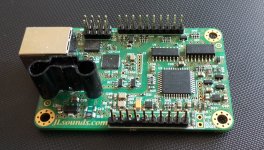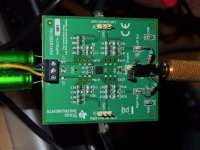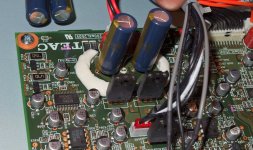No sorry, my former post was not meant for the UD-301. My UD-301 went back untouched.
But as for my listening impression, its stock form is quite a step up to the UD-H01 in stock form IMO mostly due to its more refined design, but not enough to come even close to my modded UD-H01.
So I rather decided not the go the same route again, especially as the UD-301 does not feature a dual clock and any 44.1kHz material (and multiples thereof) suffer from the same trans-sampling jitter as the UD-H01 does.
As for you modding, I would suggest to just do the same as I did with the UD-H01. Roll the capacitors first.
For the UD-301 there is a service manual and schematics to dig up in the web, so its a much easier platform for modding.
Good luck
thanks you for your hint...its good to know an expert for digital things...

There are lots of cheaper alternatives.
Check for "USB purifiers".
thank you!
do you mean this one?
I2SoverUSB - I2S over USB Audio
I would possibly give it a try as well. Any well documented mods available?
Not sure if that can be marriaged with the TEAC.
I2SoverUSB - I2S over USB Audio
I would possibly give it a try as well. Any well documented mods available?
Not sure if that can be marriaged with the TEAC.
Attachments
Last edited:
Yes. IMHO its worth every € (& I own a orig. Amanero and a lot of various Chi-Fi XMOS Interfaces. Lyuben, the designer, provides a TheSycon driver as well, something that is important as well. I'm just missing dithering for 16Bit output.
Edit: regarding the possible connection to your TEAC: forget it. even if there might be some arguable way of soldering all the I2S signals, at the end it will be a mess judging from the pictures that you've provided.
What do You think about all the various possibilities regarding I/V conversion? With the PCM1795 you have all the prospects open.... again, against the MUSES8920 The important current signals should be easily accessibly.
The important current signals should be easily accessibly.
Edit2: Because of your Professional heritage, what about a transformer based I/V?
Edit: regarding the possible connection to your TEAC: forget it. even if there might be some arguable way of soldering all the I2S signals, at the end it will be a mess judging from the pictures that you've provided.
What do You think about all the various possibilities regarding I/V conversion? With the PCM1795 you have all the prospects open.... again, against the MUSES8920
Edit2: Because of your Professional heritage, what about a transformer based I/V?
Last edited:
@ edit 1 
@ edit 2
is already in the pipe
But just as a playground, because sooner or later I will switch to a two clock DAC design. Not yet decided, but most probably an Asahi Kasei based one.
Don't want to go the full DIY route, so it will be a ready to use and relatively easy to mod platform again.
@ edit 2
is already in the pipe
But just as a playground, because sooner or later I will switch to a two clock DAC design. Not yet decided, but most probably an Asahi Kasei based one.
Don't want to go the full DIY route, so it will be a ready to use and relatively easy to mod platform again.
Last edited:
Chermann, If you're just looking out for a decent I2S (&more) interface, why not take a look at the I2SoverUSB v.III from JLsounds. It provides SPDIF out as well after reclocking and isolation. So no need for those "fancy" USB isolators.
Hi guys
fine that you are having huge knowledge in digital contect /audio.
i have no idea what is the I2S advantage...
As master DAC --> i use an Gustrad A20H. any compliants on that. USB purifiers i will check just for fun..
chris
Hi
sorry to badger you..
i ordered yesterday a ifi nano iUSB 3.0 and today its delivered

i connect the usb B to the port of tht ifi and on the "audio"usb i go to the DAC. the switch to position on (not auto)..power on...and go!
the first impression is very good. i thought that my USB DAC is very fine. since last year (win10) the gustard A20H did support the correct driver. i got problem over foobar and Tidal/master. so i have to use over e.g. tidal the standard Xcore 2.0 driver.
with this i did the first test and the ifi sounds beautiful. i never ever expect this.
after the drivers update on gustard a20H- yes since december 2018 its new , i did the test again. ...XMOS XS1-U8-MFA
, i did the test again. ...XMOS XS1-U8-MFA
actually i am not able to say which is better. the ifi driver update was not shown over tidal - so i use the XMOS XS1-U8-MFA
i will keep it for a week and try more tests.
thanks for that hint
should i keep at USB or should i try the I2S interface on my DAC????
this requested a USB-I2S board
thx
chris
sorry to badger you..
i ordered yesterday a ifi nano iUSB 3.0 and today its delivered
i connect the usb B to the port of tht ifi and on the "audio"usb i go to the DAC. the switch to position on (not auto)..power on...and go!
the first impression is very good. i thought that my USB DAC is very fine. since last year (win10) the gustard A20H did support the correct driver. i got problem over foobar and Tidal/master. so i have to use over e.g. tidal the standard Xcore 2.0 driver.
with this i did the first test and the ifi sounds beautiful. i never ever expect this.
after the drivers update on gustard a20H- yes since december 2018 its new
actually i am not able to say which is better. the ifi driver update was not shown over tidal - so i use the XMOS XS1-U8-MFA
i will keep it for a week and try more tests.
thanks for that hint
should i keep at USB or should i try the I2S interface on my DAC????
this requested a USB-I2S board
thx
chris
Also my subjective feeling is that channel separation isn't all that great as could be expected from specs. Would possibly gain further from a split PS arrangement.
Crap
Those INA1620EVM boards suck.
Its not that the channel separation of the chip is bad, its the crappy SMD (C1 - C4) capacitors that degrade common mode rejection to an unacceptable degree.
Not enough, once removed the somehow technical presentation further improves considerably towards enjoyable musicality, telling, that those capacitors were not only way off in tolerance but also severely degrading sonics by their make.
C5, C6 rail decoupling, same crap.
Best to also trash them and just place Nichicon bipolars 100uF or so at the power IN (superior to the 1000uF FC).
Also removed my input capacitors for best CMRR in a previous step.
Not quite there yet, but already way better.
Attachments
Last edited:
Yeah, C1-C4 also left me wondering given that TI states the INA part has some kind of EMI filter already integrated in the chip itself. Instead of removing C5,C6 i opted to scratch off the paint an add a few more 2u2/50v X7R and very important to add a cross cap vom +Ve to -Ve. But still I haven't listened that much to that board.
Yes, in the data sheet of the INA1620 / OPA1622 they state, that they match the four resistors to 0.004% at best which translates for the 1k at hand to a max. tolerance value of 40 mOhm.
Any degradation beyond that degrades the speced CMRR, and its sonic outcome is even worse, when its not constant over frequency.
They certainly could and should have done better. At the very least they have had to provide an in depth explanation of the stock circuitry on the EVM board, discussing such gross design flaws
@johnc124 schau oba!
Any degradation beyond that degrades the speced CMRR, and its sonic outcome is even worse, when its not constant over frequency.
They certainly could and should have done better. At the very least they have had to provide an in depth explanation of the stock circuitry on the EVM board, discussing such gross design flaws
@johnc124 schau oba!
Last edited:
Instead of removing C5,C6 i opted to scratch off the paint an add a few more 2u2/50v X7R and very important to add a cross cap vom +Ve to -Ve.
I found the original rail caps to degrade musicality, hence I removed them.
On the other hand, I use silver MICA (at the bottom of the board) in parallel to the suggested bipolar Nichicon.
PCM1795, after TINA, IMO no way to add external USB interfaceSo, what upsampling chip is used there? Probably a SRC4392 or a AK4136 ... That would be a inserting point for an external USB interface.
Attachments
for example have look here:
https://uk.farnell.com/search?st=OPA2209
I myself would not roll to OPA2209 again, but rather use the MJM2068.
But I already have plans to do a work around for the second stage using the 2x INA1620 each channel.
The INA1620 has the great benefit of providing a very closely matched resistor network capable to handle common mode signals excellent in an instrumentation amp manner.
Using two per channel would / should have the benefit to
- having the exact same input impedance for plus and minus signal
- giving a true balanced output
and the OUT of the INA1620 could feed the headphone and the XLR just as well.
https://uk.farnell.com/search?st=OPA2209
I myself would not roll to OPA2209 again, but rather use the MJM2068.
But I already have plans to do a work around for the second stage using the 2x INA1620 each channel.
The INA1620 has the great benefit of providing a very closely matched resistor network capable to handle common mode signals excellent in an instrumentation amp manner.
Using two per channel would / should have the benefit to
- having the exact same input impedance for plus and minus signal
- giving a true balanced output
and the OUT of the INA1620 could feed the headphone and the XLR just as well.
Ok mige0, nearly had the opa2209 ordered.
Farnell, who i usually order from don't do the MJM2068, is the 2068 your only other recommendation?
NJM2068M | NJM2068M New Japan Radio,, Op Amp, 27MHz, 8-Pin DMP | RS Components do the MJM2068 (DMP?)
"But I already have plans to do a work around for the second stage using the 2x INA1620 each channel.
The INA1620 has the great benefit of providing a very closely matched resistor network capable to handle common mode signals excellent in an instrumentation amp manner."
This might be beyond my skills
Farnell, who i usually order from don't do the MJM2068, is the 2068 your only other recommendation?
NJM2068M | NJM2068M New Japan Radio,, Op Amp, 27MHz, 8-Pin DMP | RS Components do the MJM2068 (DMP?)
"But I already have plans to do a work around for the second stage using the 2x INA1620 each channel.
The INA1620 has the great benefit of providing a very closely matched resistor network capable to handle common mode signals excellent in an instrumentation amp manner."
This might be beyond my skills
Last edited:
- Status
- This old topic is closed. If you want to reopen this topic, contact a moderator using the "Report Post" button.
- Home
- Source & Line
- Digital Source
- don't trash your TEAC UD-H01 DAC, pimp it!


